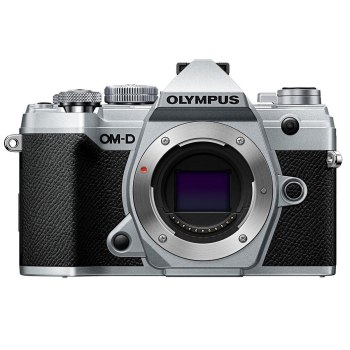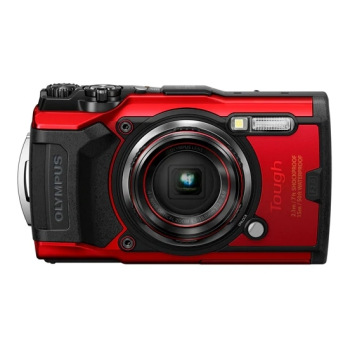- Portable and lightweight
- Excellent stabilization
- Weather-sealed
- Extremely durable
- Good macro capabilities
- GPS and sensors
- Small battery life
- No headphone jack
- Lower resolution
- Limited zoom range
Olympus OM-D E-M5 Mark III vs Olympus TG-6 Tough
When it comes to Olympus cameras, two models that stand out for their unique features and capabilities are the Olympus OM-D E-M5 Mark III and the Olympus TG-6 Tough. While both cameras are designed to capture high-quality images, they cater to different needs and preferences. In this comparison, we'll delve into the details of each camera to help you decide which one is best suited for your photography requirements.
Design and Build
The Olympus OM-D E-M5 Mark III is a mirrorless interchangeable lens camera that boasts a sleek and rugged design. Weighing in at approximately 414 grams, it features a magnesium alloy body with weather-sealing, making it dustproof and splashproof. The camera's ergonomic grip and intuitive controls make it comfortable to hold and operate.
On the other hand, the Olympus TG-6 Tough is a compact point-and-shoot camera that's built for extreme conditions. With a weight of around 253 grams, it's significantly lighter than the E-M5 Mark III. The TG-6 features a ruggedized body with a reinforced construction, making it waterproof up to 15 meters, shockproof from heights of up to 2.4 meters, and freezeproof down to -10°C.
Image Quality
The Olympus OM-D E-M5 Mark III is equipped with a 20.4-megapixel Micro Four Thirds sensor, which delivers excellent image quality with impressive detail and color accuracy. The camera's TruePic VIII image processor enables fast autofocus, reduced noise, and improved dynamic range. Additionally, the E-M5 Mark III features in-body image stabilization (IBIS), which helps to reduce camera shake and blur.
In contrast, the Olympus TG-6 Tough has a 12-megapixel 1/2.3-inch BSI CMOS sensor, which is better suited for casual photography and everyday shooting. While it may not match the E-M5 Mark III's image quality, the TG-6 still produces respectable results with good color rendition and decent low-light performance.
Lens and Zoom
The Olympus OM-D E-M5 Mark III has a interchangeable lens system, allowing you to choose from a wide range of Micro Four Thirds lenses. This provides flexibility and versatility for various photography applications, including portrait, landscape, sports, and wildlife shooting.
The Olympus TG-6 Tough, on the other hand, features a fixed 25-100mm (equivalent) zoom lens with an aperture range of f/2-4.9. While it may not offer the same level of flexibility as the E-M5 Mark III's interchangeable lens system, the TG-6's lens is well-suited for everyday shooting and provides a convenient all-in-one solution.
Video Capabilities
Both cameras are capable of recording high-quality video, but the Olympus OM-D E-M5 Mark III has a clear advantage in this regard. It can shoot 4K video at up to 30p, as well as 1080p at up to 120fps for smooth slow-motion footage. The camera also features advanced video modes like OM-Log and Flat mode, which provide greater flexibility during post-production.
The Olympus TG-6 Tough, while capable of recording 4K video at up to 30p, is more limited in its video capabilities compared to the E-M5 Mark III. However, it still produces respectable results and features a range of video modes, including time-lapse and slow-motion recording.
Additional Features
The Olympus OM-D E-M5 Mark III features a vari-angle touchscreen LCD, built-in Wi-Fi and Bluetooth connectivity, and a robust autofocus system with 121 phase-detection points. It also has a range of advanced features like focus stacking, live composite mode, and in-camera focus bracketing.
The Olympus TG-6 Tough, on the other hand, features a 3-inch LCD screen, built-in GPS, and a range of shooting modes like microscope mode, which allows for extreme close-up photography. It also has a built-in LED light, which can be useful for macro photography or low-light situations.
Conclusion
In conclusion, when it comes to Olympus cameras, the OM-D E-M5 Mark III and TG-6 Tough cater to different needs and preferences. The E-M5 Mark III is a high-end mirrorless camera that excels in image quality, video capabilities, and advanced features, making it ideal for enthusiasts and professionals.
The TG-6 Tough, on the other hand, is a ruggedized point-and-shoot camera that's perfect for casual photography, outdoor adventures, or extreme conditions. While it may not match the E-M5 Mark III's image quality, it provides a convenient all-in-one solution with a range of features that make it well-suited for everyday shooting.
Ultimately, the choice between these two Olympus cameras depends on your specific needs and preferences. If you're looking for a high-end camera with advanced features and exceptional image quality, the OM-D E-M5 Mark III is the clear winner. However, if you need a ruggedized camera that can withstand extreme conditions and provide reliable results in a compact package, the TG-6 Tough is an excellent choice.































